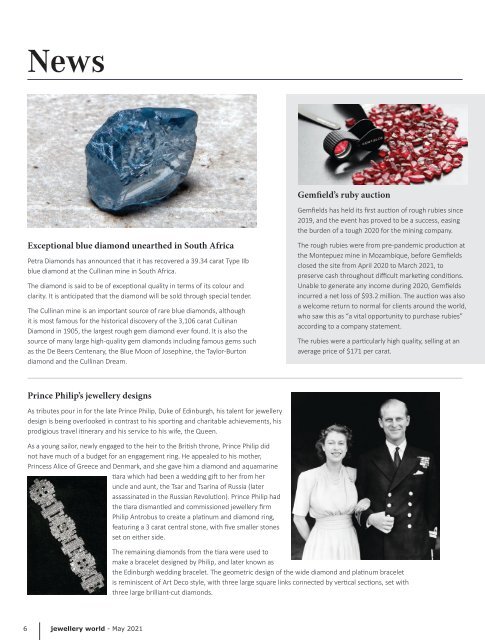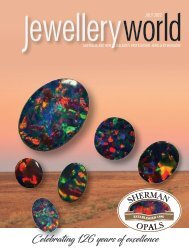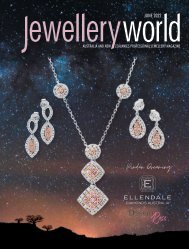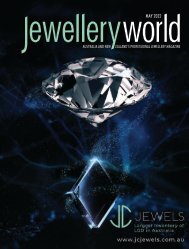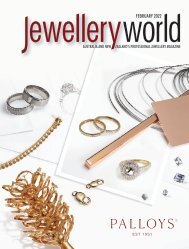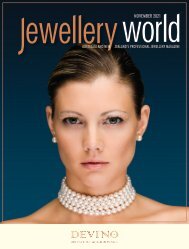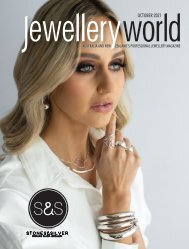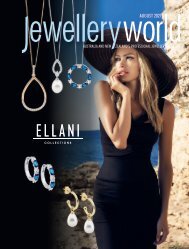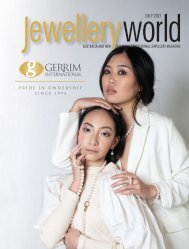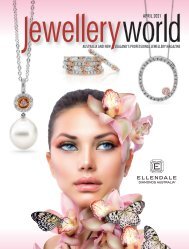Jewellery World Magazine - May 2021
You also want an ePaper? Increase the reach of your titles
YUMPU automatically turns print PDFs into web optimized ePapers that Google loves.
News<br />
Gemfield’s ruby auction<br />
Exceptional blue diamond unearthed in South Africa<br />
Petra Diamonds has announced that it has recovered a 39.34 carat Type IIb<br />
blue diamond at the Cullinan mine in South Africa.<br />
The diamond is said to be of exceptional quality in terms of its colour and<br />
clarity. It is anticipated that the diamond will be sold through special tender.<br />
The Cullinan mine is an important source of rare blue diamonds, although<br />
it is most famous for the historical discovery of the 3,106 carat Cullinan<br />
Diamond in 1905, the largest rough gem diamond ever found. It is also the<br />
source of many large high-quality gem diamonds including famous gems such<br />
as the De Beers Centenary, the Blue Moon of Josephine, the Taylor-Burton<br />
diamond and the Cullinan Dream.<br />
Gemfields has held its first auction of rough rubies since<br />
2019, and the event has proved to be a success, easing<br />
the burden of a tough 2020 for the mining company.<br />
The rough rubies were from pre-pandemic production at<br />
the Montepuez mine in Mozambique, before Gemfields<br />
closed the site from April 2020 to March <strong>2021</strong>, to<br />
preserve cash throughout difficult marketing conditions.<br />
Unable to generate any income during 2020, Gemfields<br />
incurred a net loss of $93.2 million. The auction was also<br />
a welcome return to normal for clients around the world,<br />
who saw this as “a vital opportunity to purchase rubies”<br />
according to a company statement.<br />
The rubies were a particularly high quality, selling at an<br />
average price of $171 per carat.<br />
Prince Philip’s jewellery designs<br />
As tributes pour in for the late Prince Philip, Duke of Edinburgh, his talent for jewellery<br />
design is being overlooked in contrast to his sporting and charitable achievements, his<br />
prodigious travel itinerary and his service to his wife, the Queen.<br />
As a young sailor, newly engaged to the heir to the British throne, Prince Philip did<br />
not have much of a budget for an engagement ring. He appealed to his mother,<br />
Princess Alice of Greece and Denmark, and she gave him a diamond and aquamarine<br />
tiara which had been a wedding gift to her from her<br />
uncle and aunt, the Tsar and Tsarina of Russia (later<br />
assassinated in the Russian Revolution). Prince Philip had<br />
the tiara dismantled and commissioned jewellery firm<br />
Philip Antrobus to create a platinum and diamond ring,<br />
featuring a 3 carat central stone, with five smaller stones<br />
set on either side.<br />
The remaining diamonds from the tiara were used to<br />
make a bracelet designed by Philip, and later known as<br />
the Edinburgh wedding bracelet. The geometric design of the wide diamond and platinum bracelet<br />
is reminiscent of Art Deco style, with three large square links connected by vertical sections, set with<br />
three large brilliant-cut diamonds.<br />
6<br />
jewellery world - <strong>May</strong> <strong>2021</strong>


